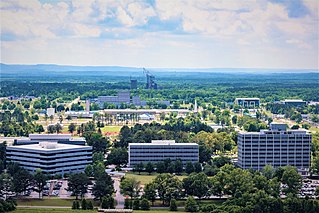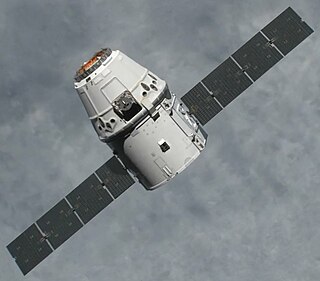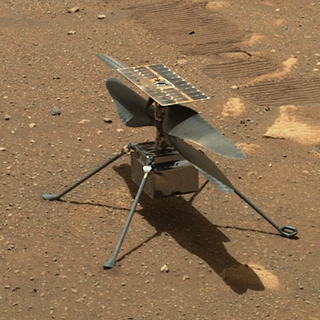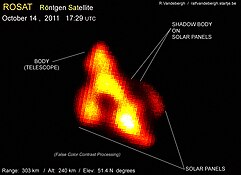
Space exploration is the use of astronomy and space technology to explore outer space. While the exploration of space is currently carried out mainly by astronomers with telescopes, its physical exploration is conducted both by uncrewed robotic space probes and human spaceflight. Space exploration, like its classical form astronomy, is one of the main sources for space science.

A space telescope is a telescope in outer space used to observe astronomical objects. Suggested by Lyman Spitzer in 1946, the first operational telescopes were the American Orbiting Astronomical Observatory, OAO-2 launched in 1968, and the Soviet Orion 1 ultraviolet telescope aboard space station Salyut 1 in 1971. Space telescopes avoid several problems caused by the atmosphere, including the absorption or scattering of certain wavelengths of light, obstruction by clouds, and distortions due to atmospheric refraction such as twinkling. Space telescopes can also observe dim objects during the daytime, and they avoid light pollution which ground-based observatories encounter. They are divided into two types: Satellites which map the entire sky, and satellites which focus on selected astronomical objects or parts of the sky and beyond. Space telescopes are distinct from Earth imaging satellites, which point toward Earth for satellite imaging, applied for weather analysis, espionage, and other types of information gathering.

Moon landing conspiracy theories claim that some or all elements of the Apollo program and the associated Moon landings were hoaxes staged by NASA, possibly with the aid of other organizations. The most notable claim of these conspiracy theories is that the six crewed landings (1969–1972) were faked and that twelve Apollo astronauts did not actually land on the Moon. Various groups and individuals have made claims since the mid-1970s that NASA and others knowingly misled the public into believing the landings happened, by manufacturing, tampering with, or destroying evidence including photos, telemetry tapes, radio and TV transmissions, and Moon rock samples.

The George C. Marshall Space Flight Center (MSFC), located in Redstone Arsenal, Alabama, is the U.S. government's civilian rocketry and spacecraft propulsion research center. As the largest NASA center, MSFC's first mission was developing the Saturn launch vehicles for the Apollo program. Marshall has been the lead center for the Space Shuttle main propulsion and external tank; payloads and related crew training; International Space Station (ISS) design and assembly; computers, networks, and information management; and the Space Launch System. Located on the Redstone Arsenal near Huntsville, MSFC is named in honor of General of the Army George C. Marshall.

The Blue Marble is a photograph of Earth taken on December 7, 1972, from a distance of around 29,400 km (18,300 mi) from Earth's surface.

John Mace Grunsfeld is an American physicist and a former NASA astronaut. He is a veteran of five Space Shuttle flights and has served as NASA Chief Scientist. His academic background includes research in high energy astrophysics, cosmic ray physics and the emerging field of exoplanet studies with specific interest in future astronomical instrumentation. After retiring from NASA in 2009, he served as the deputy director of the Space Telescope Science Institute in Baltimore, Maryland. In January 2012, he returned to NASA and served as associate administrator of NASA's Science Mission Directorate (SMD). Grunsfeld announced his retirement from NASA in April 2016.

ROSAT was a German Aerospace Center-led satellite X-ray telescope, with instruments built by West Germany, the United Kingdom and the United States. It was launched on 1 June 1990, on a Delta II rocket from Cape Canaveral, on what was initially designed as an 18-month mission, with provision for up to five years of operation. ROSAT operated for over eight years, finally shutting down on 12 February 1999.

The following outline is provided as an overview of and topical guide to space exploration.

Space art, also known as astronomical art, is a genre that focuses on visual representations of the universe. This genre includes various styles, such as realism, impressionism, abstract imagery, and sculpture. Though artists have long produced art with astronomical elements, the genre of space art itself began only when technological advancement allowed for more detailed observation of the night sky. Space art also attempts to communicate ideas related to space, often including an artistic interpretation of cosmological phenomena and scientific discoveries. In some cases, space artists use more than illustration and painting to communicate astronomy or works depicting space. Several space artists work directly with scientists developing spaceflight technology in attempts to expand the arts, humanities, and cultural expression relative to space exploration.

Third-party evidence for Apollo Moon landings is evidence, or analysis of evidence, about the Moon landings that does not come from either NASA or the U.S. government, or the Apollo Moon landing hoax theorists. This evidence provides independent confirmation of NASA's account of the six Apollo program Moon missions flown between 1969 and 1972.

The National Aeronautics and Space Administration is an independent agency of the U.S. federal government responsible for the civil space program, aeronautics research, and space research. Established in 1958, it succeeded the National Advisory Committee for Aeronautics (NACA) to give the U.S. space development effort a distinct civilian orientation, emphasizing peaceful applications in space science. It has since led most of America's space exploration programs, including Project Mercury, Project Gemini, the 1968–1972 Apollo Moon landing missions, the Skylab space station, and the Space Shuttle. Currently, NASA supports the International Space Station (ISS) along with the Commercial Crew Program, and oversees the development of the Orion spacecraft and the Space Launch System for the lunar Artemis program.

Aleksandr Mikhailovich Samokutyaev is a Russian politician and former cosmonaut. Samokutyaev served as a Flight Engineer for the International Space Station (ISS) long duration Expedition 27/28 missions. He also served as the Soyuz TMA-21 commander. He most recently served on the Soyuz TMA-14M Expedition 41/42 crew aboard the ISS. He was hired as a cosmonaut in the summer of 2003.

Space research is scientific study carried out in outer space, and by studying outer space. From the use of space technology to the observable universe, space research is a wide research field. Earth science, materials science, biology, medicine, and physics all apply to the space research environment. The term includes scientific payloads at any altitude from deep space to low Earth orbit, extended to include sounding rocket research in the upper atmosphere, and high-altitude balloons.

The year 2012 saw a number of significant events in spaceflight. In May and October, the first Commercial Orbital Transportation Services resupply missions took place, during which the SpaceX Dragon became the first private spacecraft to dock with the International Space Station (ISS). In June, China launched the crewed Shenzhou 9 orbital mission, and North Korea achieved its first successful orbital launch in December. 2012 also saw China's first successful asteroid exploration mission, and the landing of NASA's Curiosity rover on Mars. The Vega and Unha-3 rockets made their maiden flights in 2012, while the Proton-K made its last.

In 2015, the maiden spaceflights of the Chinese Long March 6 and Long March 11 launch vehicles took place.

The Day the Earth Smiled is a composite photograph taken by the NASA spacecraft Cassini on July 19, 2013. During an eclipse of the Sun, the spacecraft turned to image Saturn and most of its visible ring system, as well as Earth and the Moon as distant pale dots. The spacecraft had twice taken similar photographs in its previous nine years in orbit around the planet. The name also refers to the activities associated with the event, as well as to the photographic mosaic created from it.

A space selfie is a selfie that is taken in outer space. This include selfies taken by astronauts, machines and by indirect methods.

The year 2021 broke the record for the most orbital launch attempts till then (146) and most humans in space concurrently (19) despite the effects of COVID-19 pandemic.

The year 2023 saw rapid growth and significant technical achievements in spaceflight. For the third year in a row, new world records were set for both orbital launch attempts (223) and successful orbital launches (211). The growth in orbital launch cadence can in large part be attributed to SpaceX, as they increased their number of launches from 61 in 2022 to 98 in 2023. The deployment of the Starlink satellite megaconstellation was a major contributing factor to this increase over previous years. This year also featured numerous maiden launches of new launch vehicles. In particular, SSLV, Qaem 100, Tianlong-2, Chollima-1,and Zhuque-2 performed their first successful orbital launch, while SpaceX's Starship – the world's largest rocket – launched two times during its development stage: IFT-1 and IFT-2.
Photography and other imagery of planet Earth from outer space started in the 1940s, first from rockets in suborbital flight, subsequently from satellites around Earth, and then from spacecraft beyond Earth's orbit.




















